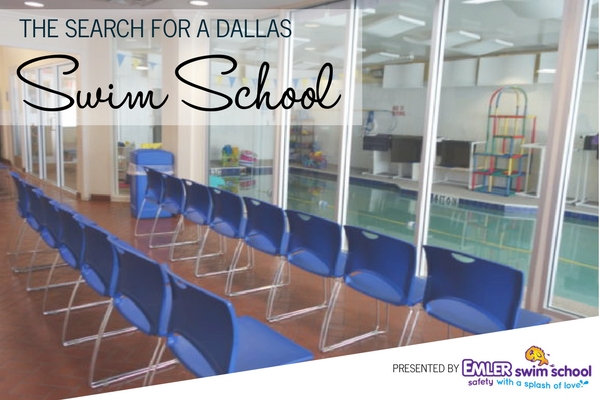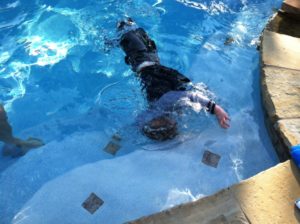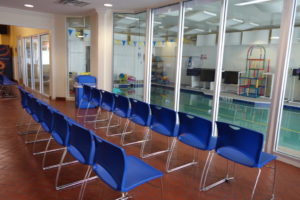Summer is almost here and we’re ready to start dusting off our sprinklers and blowing up some floaties! As the weather starts to warm up and we get closer to slipping on our swimsuits, Dallas Moms Blog and Emler Swim School bring you a new post each week focusing on water fun & safety. Join us as we Splash into Summer!
In my occupation as a medicolegal death investigator, I see many deaths each month that we in the industry call “needless deaths.” These are deaths that were completely preventable and are often the most frustrating. Unfortunately, a lot of these deaths are water-related child fatalities and all of them had some lapse in supervision. In other words, no one was watching the child or they were being supervised by someone who was otherwise distracted.
Just in case you think I am trying to scare you, consider this: According to the World Health Organization (WHO), drowning is the third leading cause of unintentional deaths. In the United States, drowning is the second leading cause of unintentional injury death in children between 1-14 years of age. Age is one of the major risk factors for drowning. According to WHO, the highest drowning rates are among children 1-4 years, followed by children 5-9 years worldwide.
It makes sense, right? Younger children are less likely to be strong swimmers and thus drown at a higher rate.
So when my twins were born, we decided to look into swim lessons at a young age. In addition to an attentive adult in the water, a child that is comfortable swimming greatly decreases the likelihood of a childhood water-related injury or drowning.
There are a lot of options for parents ranging from swim schools, community recreational centers, private lessons in private pools and Infant Safety Resource Self Rescue (ISR). Here’s what we tried and what I found with each. . .

Infant Safety Resource Self Rescue

We started in an Infant Safety Resource Self Rescue (ISR) program at about 21 months of age. These are the kids in videos where you see them fall into a pool fully clothed and then they float and swim until they get to an exit for the pool, or help arrives.
Generally, in ISR the parent brings the child to a private pool and there is a ten-minute lesson five days a week for about 7-10 weeks. The ten minutes in the water are strenuous and repetitive movements and monitored by the trained instructor. There is no parental interaction with your child in the pool and the lesson is strictly one on one with the child and the teacher. The goal of this lesson is to get the small child to swim, flip and float to rest, and the swim again until they reach the side of the pool or until help arrives. The sessions build on the skills until the child can rescue themselves by going to a pool exit or shoreline after “falling” in fully clothed. This test is built on the concept that most kids do not fall into a pool in a swimsuit. Rather, the child wanders off or goes into the water fully clothed when someone is not watching.
I’m going to be honest. I found ISR swim to be difficult because I would spend 40 minutes driving for 20 minutes of lessons for my twins. Then I would spend another 20 minutes changing my children to dry clothes on someone’s patio and loading them up in my car.
Despite all this effort, I am happy with the choice to start my boys swimming this rigorously at this age. My twins did this each summer for about three years and each year we saw tremendous improvement in swimming ability, confidence and self-rescue efforts.
Red Cross Swimming
After it became apparent that my children could likely rescue themselves in the few seconds they would need for an attentive adult to respond, we moved to a Red Cross Swimming curriculum at a private pool with a private swim instructor.
In a Red Cross Swim program, there are various levels for children and adults, and the goals for each level are clearly laid out on their webpage. My kids are typically dropped off at a private pool for a 25 minute class for four to five days a week for several weeks over the summer. The parents then wait out of sight until the class is over. Each class starts off with the kids briefly talking about water safety topics and then progresses into the pool. When children are younger, there are always 2-3 instructors around and there is always someone with eyes on my child.
The lessons provided in this type of class focus on repetition of motions and techniques, so that it eventually becomes second nature to the child. Each lesson builds on the motions previously learned by the child until they get into more advanced swimming strokes. At the end of the session, parents get observation days where you can see the progress and watch your child’s lesson from outside the pool.
Emler Swim School

For a more traditional style swim school, Emler Swim School has class sessions for babies as young as 2 months old. I was reading about Emler’s Bathtime Babies class, which teaches parents about water safety at bath time and gets children used to a positive water experience from 2-5 months old. This concept is GENIUS and totally necessary. You’d think most people would know some of this stuff, but we still get bathtub drownings over and over at work.
Children can eventually grow into the various Waterbabies and Aquatots classes offered. Some of these classes start out with the parent in the pool with the child and then progress to where the parent can eventually observe the class.
What may parents love about Emler is that it becomes a “family” type environment? Similar to a Gymboree or The Little Gym, you get to know the other parents in the classes whose kids are around the same age as yours.
Regardless of your family’s preference in swim lessons or when you decide to enroll, there are some basic water safety rules all people should use when swimming. In addition to Cassidy’s from our 1st post in this series, here are a few rules that should apply anytime your child is near water:
- Always swim with a buddy or friend. Having someone there when you are in distress is a huge deal. It can be a matter of life and death.
- Know that even shallow bodies of water can be dangerous. Kids can drown in less than two inches of water. Parents should be watching closely even in a small, plastic child’s pool, around buckets of water and in the tub.
- Observe safety signs and follow the instructions. This can be pool signs, “no diving” signs, “no swimming” signs or posted beach information about currents. Do your homework about other safety hazards that may be lurking in the water or area where you are visiting.
- Use flotation devices properly and be sure they are fitted properly on the child. And always wear a U.S. Coast Guard approved life jacket in a lake or ocean.
- Don’t rely on the fact that you have a life jacket or flotation device. People still drown in those.
- Never, ever leave children unattended. Ever. Not even for a minute. Not in their Puddle Jumper. Not ever. In fact, have a designated water watcher who has their eyes on the body of water at all times. If that person can not watch the water for a few minutes, there should be a clear hand-off of responsibility to an attentive adult.
- Be within an arms reach of your child while they are in the water. It only takes seconds to take in too much water which can result in severe health consequences or death.
- Avoid alcohol use while swimming, or if you are the designated water watcher. This is just common sense, but so hard for people who are vacationing or lounging poolside. Alcohol slows response time and effects good judgement. Have one responsible adult who is not drinking.
- Have fun. If you are in the water with your kids, not only will they have you there to protect them if they go under, you will be making fun memories and spending quality time together.
I can repeatedly tell you teaching someone to swim is a valuable lesson, but nothing drives the point home like a good story.
My parents have a pool and on a nice January day, the twins were in the backyard at my parent’s house enjoying the weather. One of my sons was walking around the pool, fully clothed, when he lost his footing and fell in. My father was standing right by him, witnessed the fall, and went to reach out and grab my 6 year old. My son automatically rolled on his back, got air, floated and then reached for the side wall as my dad was plucking him from the icy water.
I can say with a pretty accurate level of certainty, my kid only knew to do this because of the years of swimming lessons.

For more information on Emler Swim School, including videos, posts and other water safety tips for parents, Emler Swim School’s page on Water Safety!
If you’re looking for additional ways to keep children safe in the water this summer, Emler Swim School provides a variety of classes for children starting as young as 2 months and they encourage you to reach out and find the right class for your family. To learn more about Emler Swim School in Dallas/Fort Worth, make sure to visit their website or Facebook page.













